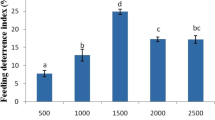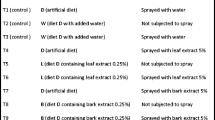Abstract
Methanolic extract ofMelia azedarach fruits enriched by washing with petrolether and ethyl acetate was used for laboratory treatments of two lepidopteran pests in Egypt. The experiments were carried out with concentrations of 10, 15, 25, 50, 100 and 1000 ppm in a diet and compared with control insects. In both insects food consumption, weight gain and conversion of ingested food (ECI) in body matter decreased with increasing extract amounts. The conversion of digested food (ECD) was lowered gradually by using higher concentrations ofMelia extract. Some antifeedant activity was observed in larvae ofS. littoralis andA. ipsilon. The percentage of mortality increased with application of higher concentrations ofMelia extract in both species. Starting from 3rd larval instar the larvae of both species reduced significantly their weight until pupation in 25 ppm and higher extract concentrations, while the larval period was prolonged. The pupal weight was significantly reduced at 15, 25 and 50 ppm. At higher concentrations the larvae failed to pupate. Duration of pupal period was affected only inA. ipsilon. All reproduction parameters, as period of oviposition, fecundity, fertility and longevity of males and females were affected using emerged adults from treated larvae with concentrations of 10, 15 and 25 ppmMelia extract. InS. littoralis no adult emerged from pupae originated from larvae treated with 50 ppm and higher amounts and no larva hatched from eggs laid by adults treated with 25 ppmMelia concentration as larvae. In both species the oviposition period was shortened at 15 and 25 ppm extract, the fecundity and fertility were drastically reduced, and the longevity of males and females was reduced. Cross sections of the midgut showed that the epithelial cells are destroyed in both pests. This can be one of the reasons for the observed effects.
Zusammenfassung
Ein methanolischer Extrakt vonMelia azedarach-Früchten aus Griechenland wurde auf seine insektizide Wirkung bei Raupen zweier schädlicher Lepidopteren (S. littoralis undA. ipsilon) unter Laborbedingungen untersucht. Der Extrakt wurde zuvor mit Petrolether und Ethylacetat gereinigt. Für die Experimente wurden neben der Kontrolle Konzentrationen von 10, 15, 25, 50, 100 und 1000 ppm mit einer Diät verfüttert. Bei beiden Insektenarten sank die. Nahrungsaufnahme, die Gewichtszunahme und die Umwandlung der aufgenommenen Nahrung (ECI) in Biomasse mit zunehmender Extraktkonzentration in der Nahrung ab. Der Verbrauch der verdauten Nahrungsmenge (ECD) wurde mit höhererMelia-Extraktmenge graduell geringer. Sowohl bei den Raupen vonS. littoralis als auch beiA. ipsilon wurde ein gewisses Antifeedant-Verhalten beobachtet. Die Mortalität stieg mit erhöhterMelia-Konzentration in der Diät bei beiden Arten an. Mit Beginn des 3. Larvenstadiums wurde das Gewicht bei beiden Arten bis zur Verpuppung bei 25 ppm und höheren Konzentrationen signifikant reduziert, während die Larvalperiode verlängert wurde. Das Puppengewicht war signifkant niedriger, ween Diäten mit Konzentrationen von 15, 25 und 50 ppmMelia-Extrakt verabreicht wurden. Bei höheren Konzentrationen verpuppten sich die Larven nicht mehr. Die Puppenperiode wurde nur beiA. ipsilon beeinflußt. Alle die Rcproduktion betreffenden Parameter, wie Eiablagezeit, Fekundität, Fertilität und Lebenszeit der adulten Männchen und Weibchen, wurden beeinflußt, wenn die Larven mit Konzentrationen von 10, 15 und 25 ppmMelia-Extrakt aufwuchsen. BeiS. littoralis schlüpfte kein Falter, wenn die Raupen mit 50 ppm und mehr gefüttert wurden, und keine Larve schlüpfte aus Eiern, die von Weibchen abgelegt wurden, die als Larven 25 ppmMelia-Extrakt in der Diät erhielten. Bei beiden Arten war die Ovipositionszeit verkürzt, wenn ihnen 15 und 25 ppmMelia-Extrakt mit der Diät verabreicht wurden; die Fekundität und Fertilität waren stark reduziert, und die Lebenszeit war sowohl bei Männchen als auch bei Weibchen verkürzt. Querschnitte durch den Mitteldarm zeigten, daß bei Raupen beider Arten, die mit 100 ppmMelia-Extrakt in der Diät gefüttert wurden, das Darmepithel stark zerstört war, was als eine Ursache für die beobachteten Effekte angesehen wurde.
Similar content being viewed by others
Literature
Ahmed, S.; Grainge, M.; Hylin, J. W.; Mitchel, W. C.; Litsinger, J. A., 1984: Some promising plant species for use as pest control agents under traditional farming system. Proc. 2nd Int. Neem Conf. (Rauischholtshausen 1983), 565–580.
Arnason, J. T.;Philogene, B. J. R.;Donskov, N.;Kubo, I., 1987: Limonoids from the Meliaccae and Rutaceae reduce feeding, growth and development ofOstrinia nubilalis. Ent. exp. & appl.43, 221–226.
Bhanderi, D. S.;Govil, H. N., 1978: Evaluation of fodder tree leaves for sheep and goat in Semi Arid Area of Rajasthan. J. Nucl. Agric. Biol.7 (1), 110–113.
Breuer, M.;Devkota, B., 1990: Control ofThaumetopoea pityocampa (Den. & Schiff.) by extracts ofMelia azedarach L. (Meliaceae). J. Appl. Ent.110, 128–135.
Breuer, M.;Schmidt, G. H., 1990: Untersuchungen zur Wirkung vonMelia azedarach-Extrakt aufSpodoptera frugiperda (J. E. Smith) (Lepidoptera: Noctuidae). Mitt. Dtsch. Ges. Allg. Ang. Ent.7, 419–429.
Breuer, M.;Schmidt, G. H., 1995: Einfluß einer kurzzeitigen Behandlung mitMelia azedarach-Extrakt über Blattmaterial auf Nahrungsaufnahme und Wachstum der Larven vonSpodoptera frugiperda (J. E. Smith) (Lep., Noctuidae). Zeitschr. Pflanzenkr. Pflanzensch.102, (6), 633–654.
Breuer, M.;Schmidt, G. H., 1996: Wirkung einer mitMelia azedarach-Extrakt behandelten Raupendiät auf Wachstum, Entwicklung und Fekundität vonSpodoptera frugiperda (J. E. Smith) (Lep., Noctuidae). Zeitschr. Pflanzenkr. Pflanzensch.103, (1), 171–194.
Dimetry, N. Z.;Schmidt, G. H., 1991: Improvement of methanol extract ofMelia azedarach by some additives againstAphis fabae Scop. Boll. Zool. agr. Bachic., Ser. II.,23 (2), 143–151.
Hurst, E., 1942: Poisonous plants of New South Wales. Snelling Printing Works, Sydney, Australia.
Jacobson, M., 1986: The neem tree: natural resistence par excellence. In: Green, M. B.; Hedin, P. A. [Eds.]: Natural Resistence of Plant to Pests: Roles of Allelochemicals. ACS Symp. Ser. 296; Am. Chem. Soc. Washington, 220–232.
Johsi, B. G., 1987: Use of neem products in tobacco in India. Proc. 3rd Int. Neem Conf. (Nairobi, 1986), 479–494.
Khalifa, A.;Salama, H. S.;Sharaby, A., 1973: Rearing the cotton leafworm,Spodoptera littoralis (Boisd.) on semiartificial diet. Z. ang. Ent.173, 129–132.
Knüsli, E., 1977: Industrial aspects of the practical use of natural products or derivatives in the protection of crops. In: Marini Bettolo, G. B.: Natural Products and the Protection of Plants. Pontificiae Academiae Scientiarium Scripta Varia41, 755
Kraus, W.; Cramer, R.; Bokel, M.; Sawitzki,. G. 1981: New insect antifeedants fromAzadirachta indica andMelia azedarach Proc. 1st Int. Neem. Conf., (Rottach-Egern 1980), 53–62.
Kraus, W.;Bokel, M.;Klenk A.;Pöhnl H., 1985: The structure of azradirachtin and 22, 23 dihydro-23 B-methoxy azadirachtin. Tetrahedron Lett.26, 6435–6438.
Kraus, W., 1986: Constituents of neem and related species. A revised structure of azadirachtin. In:Rahman, A.; le Quesne, P. W.: New Trents in Natural Product Chemistry. elsevier Science Publishers B. V., Amsterdam, 237–256.
Kraus, W.; Baumann, S.; Bokel, M.; Keller, U.; Klenk, A.; Klingele, M.; Pöhnl, H.; Schwinger, M., 1987: Control of Insect feeding and development by constituents ofMelia azedarach andAzadirachta indica. Proc. 3rd Neem Conf., (Nairobi 1986), 111–125.
Morrison, F. R.;Grant, R., 1932: Contribution on the chemistry of the fruit obtained from the white cedar tree (Melia azedarach L. var.australasia C. DC: Syn.Melia australasia A. Juss) growing in New South Wales, with notes on its reputed toxicity. Proc. R. Soc. New South Wales65, 153.
Morton, J. F., 1982: Plant poisonous to people in Florida and other warm areas. 2nd edn: Southeastern Printing Co, Stuart, Florida, USA, 32 pp.
Oelrichs, P. B.;Hill, M. W.;Vallely, P. J. Macleod, J. K.;Mlinski, T. F., 1983: Toxic tetranortriterpenes of the fruit ofMelia azedarach. Phytochemistry22 (2), 531–534.
Pandey, U. K.;Pandey, M.;Chuahan, S. P. S., 1981: Insecticidal properties of some plant material extracts against painted bug,Bagrada cruciferarum Kirk. Ind. J. Ent.43 (4), 404–407.
Rao, P. I.;Subrahmanyam, B., 1986: Azadirachtin, induced changes in development, food utilization and haemolymph constituents ofSchistocerca gregaria (Forskal). J. Appl. Ent.102, 217–224.
Rembold, H.; Forster, H.; Czoppelt, C., 1987 a: Structure and biological activity of azadirachtin A and B. Proc. 3rd Int. Neem Conf. (Nairobi 1986), 149–160.
Rembold, H.;Forster, H.;Sonnenbichler, J., 1987b: Structure of azadirachtin B. Z. Naturf.42 C, 4–6.
Rembold, H., 1989; Isomeric azadirachtins and their mode of action. In:Jacobson; M: Focuson phytochemical pesticides: Vol I. The neem tree. CRC Press, Boca Raton, Florida, USA, p. 47–67.
Rembold, H., 1990: Azadirachtins: Their structure and mode of action. InArnason, J. T., Philogene, B. J. R.;Morand, P. [Eds.]. Insecticides of Plant Origin. — ACS Symp. Ser. 387; American Chemical Society, Washington, D. C., USA, p. 150–163.
Romeis, B., 1968: Mikroskopische Technik. Text book. p. 69–102, 596–597.
Saleh, M. A.;El-Bolok, M. M.;Abdel-Salam, K. A.;Ibrahim, N. A., 1986: Plant extracts affecting insect feeding, growth and metamorphosis. Bull. Agric. Univ. Cairo37 (1), 529–539.
Schmidt, G. H., 1986: Pestizide und Umweltschutz. Vieweg & Sohn, Braunschweig, 466 pp.
Schmutterer, H.; Ascher, K. R. S.; Rembold, H. [Eds.], 1981: Natural pesticides from the neem tree (Azadirachta indica A. Juss). Proc. 1st. Int. Neem Conf. (Rottach-Egern 1980), 297 pp.
Schmutterer, H.; Ascher, K. R. S. [Eds.], 1984: Natural pesticides from the neem tree (Azadirachta indica A. Juss) and other tropical plants. Proc. 2nd. Int. Neem Conf. (Rauischholtshausen 1983), 587 pp.
Schmutterer, H.; Ascher, K. R. S. [Eds.], 1984: Natural pesticides from the neem tree (Azadirachta indica A. Juss) and other tropical plants. Proc. 3rd. Int. Neem Conf. (Nairobi 1986), 703 pp.
Schmutterer, H., 1985: The Neem Tree. VCH, Weinheim-New York, 696 pp.
Schulte, K. E.;Rucker, G.;Matern, H. U., 1979: Über einige Inhaltsstoffe der Früchte und Wurzeln vonMelia azedarach L. Planta medica35, 76–83.
Srivastava S. K.;Gupta, H. O., 1985: New limonoids from the roots ofMelia azedarach L. Indian J. Chem.24 B, 166–170.
Steyn, D. G.;Rindl, M., 1929: Preliminary report on the toxicity of the fruits ofMelia azedarach (syringa berries). Trans R. Soc. S. Afr.17, 295.
Waldbauer, G. P., 1968: The composition and utilization of food by insects, Adv. Insect Physiol.5, 229–288.
Yamasaki, R. B.;Ritland, T. G.;Barnby, M. A.;Klocke, J. A., 1988: Isolation and purification of solanin from neem seeds and its quantification in neem and chinaberry seeds and leaves. J. Chromat.447 (1), 277–283.
Author information
Authors and Affiliations
Additional information
The experiments were carried out at LG Zoologie-Entomologie, FB Biologie, University of Hannover, F. R. G. and were funded by the Scientific Channel System between the Arab Republic of Egypt and the Federal Republic of Germany.
Rights and permissions
About this article
Cite this article
Schmidt, G.H., Ahmed, A.A.I. & Breuer, M. Effect ofMelia azedarach extract on larval development and reproduction parameters ofSpodoptera littoralis (Boisd.) andAgrotis ipsilon (Hufn.) (lep. noctuidae). Anz. Schadlingskde., Pflanzenschutz, Umweltschutz 70, 4–12 (1997). https://doi.org/10.1007/BF02009609
Issue Date:
DOI: https://doi.org/10.1007/BF02009609




